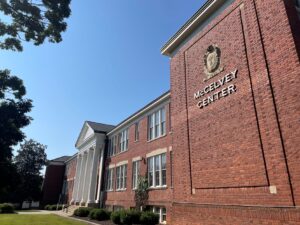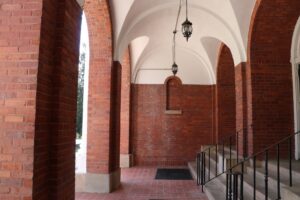
Great news about our McCelvey Center at 212 E. Jefferson Street, York, SC!
It is now listed on the National Register of Historic Places. Maintained by the United States Department of the Interior National Park Service, NRHP is the official list of the nation’s historic places worthy of preservation.
Registered under its historic name, “York Graded School,” the McCelvey Center has gone by other names, such as York Elementary School and McCelvey Elementary School. Recognized for its many years as an educational institution with “significant contribution to the broad patterns of history,” the NRHP also classifies the McCelvey building as an “excellent local example of Neoclassical architecture.”

Prepared by Culture & Heritage Museums’ Preservation/Restoration Specialist, Sara Johnson, and Director of Archives, Nancy Sambets, the nomination proposal outlined two criterions, architecture and education, for the National Register of Historic Places: The McCelvey Center building retains its character-defining features from 1922, its noted period of architectural significance. The former York Graded School was built in two major building campaigns in 1902 and 1922 with substantial renovations occurring in 1956. The current west wing was built in 1902 as a stand-alone school building built on the stone foundations of an 1853 school building that burned in 1900. The 1922 expansion, which altered the principal façade from its former west entrance to its current north entrance facing East Jefferson Street, features a Neoclassical entry portico with Ionic columns and groin-vaulted entry loggia. Character-defining elements are also noted in the McCelvey’s original exterior materials, including red brick with tinted mortar, stucco brick columns, prominent wood windows, and slate roof.
In the City of York, there is only one other institutional Neoclassical building — the York County Courthouse, which was constructed in 1914; both buildings were designed by native South Carolina architect William Augustus Edwards.
The McCelvey’s historic setting and well-preserved form contribute to its ‘integrity of feeling’ and conveys the character of an early twentieth century school. Intact interior character-defining features include the floorplan and layout of classrooms, classroom “cloak rooms” with built-in cabinets, and
office and classroom doors with operable transoms above. The classrooms, hallways, and auditorium still appear very much as they would have during the years that the building served as a school. Even blackboards remain on the walls in most of the classrooms.
The site’s ‘integrity of association’ with education is important to the collective memory of the community with generations of students reaching as far back as 1853. The earliest school building on the property was the Yorkville Female Collegiate Institute, a private school for white students founded in
1852 by Bethel Presbytery. When the free public-school system was established in 1889, it became the first public white school in the town of York, then known as Yorkville. Destroyed by a chimney fire in 1900, the school was rebuilt on the original stone foundation reusing its handmade bricks. York Graded School served grades 1- 12 until a new high school was built in 1951. York’s first white public school achieved full integration during the 1970-71 school year. The school was renamed McCelvey Elementary School in 1973 after George C. McCelvey, who served as principal of York Graded Schools from 1912-
1948. 1987 was the last year the building served as a public school.
Culture & Heritage Museums became stewards of the McCelvey Center in 2001 and erected a South Carolina State Historical Marker on the site’s front lawn in 2013. The building, which is temporarily closed to the public for structural repair, currently houses the museums’ objects and archival collections and serves as a public meeting space and, as a performing arts venue, home of the Southern Sound Series.
“The National Register of Historic Places listing is important because it recognizes the McCelvey building as a significant historic resource in our community, and also because it creates a thorough record of the
building’s history and architecture.” Sara Johnson, preservation/restoration specialist for Culture & Heritage Museums. “Most people assumed that the McCelvey building was already on the National Register as it is such a
recognizable structure within the community. So, we are very pleased to make this a reality based on its history and architecture.” Nancy Sambets, director of archives at the Historical Center of York County.
(Information from June 2023 notice of press release from Culture & Heritage Museums)
